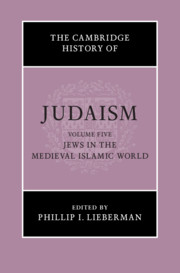Book contents
- The Cambridge History of Judaism
- The Cambridge History of Judaism
- The Cambridge History of Judaism
- Copyright page
- Contents
- Figures
- Acknowledgments
- Introduction
- Part I Jews in the Medieval Islamic World
- Part II Social and Institutional History
- Part III Spiritual and Intellectual History
- Chapter 17 Karaism
- Chapter 18 Non-Rabbinic and Non-Karaite Religious Movements
- Chapter 19 Languages and translation
- Chapter 20 Book Production
- Chapter 21 Jewish Bible Exegesis in Muslim Lands in the Middle Ages
- Chapter 22 Jewish Law
- Chapter 23 Liturgy
- Chapter 24 Piyyuṭ
- Chapter 25 Jewish Philosophy
- Chapter 26 Science and Medicine
- Chapter 27 Magic
- Chapter 28 Mysticism
- Chapter 29 Belles Lettres
- Chapter 30 Jewish-Muslim Polemics
- Chapter 31 Historiography
- Chapter 32 Material Culture, Art, and Architecture
- Index
- References
Chapter 23 - Liturgy
from Part III - Spiritual and Intellectual History
Published online by Cambridge University Press: 21 August 2021
- The Cambridge History of Judaism
- The Cambridge History of Judaism
- The Cambridge History of Judaism
- Copyright page
- Contents
- Figures
- Acknowledgments
- Introduction
- Part I Jews in the Medieval Islamic World
- Part II Social and Institutional History
- Part III Spiritual and Intellectual History
- Chapter 17 Karaism
- Chapter 18 Non-Rabbinic and Non-Karaite Religious Movements
- Chapter 19 Languages and translation
- Chapter 20 Book Production
- Chapter 21 Jewish Bible Exegesis in Muslim Lands in the Middle Ages
- Chapter 22 Jewish Law
- Chapter 23 Liturgy
- Chapter 24 Piyyuṭ
- Chapter 25 Jewish Philosophy
- Chapter 26 Science and Medicine
- Chapter 27 Magic
- Chapter 28 Mysticism
- Chapter 29 Belles Lettres
- Chapter 30 Jewish-Muslim Polemics
- Chapter 31 Historiography
- Chapter 32 Material Culture, Art, and Architecture
- Index
- References
Summary
Any serious effort to compose an historical description of the liturgy of Judaism in the Middle Ages must at the outset overcome a number of serious obstacles. First, the whole notion of “the Middle Ages” is one with which students of Islam, Judaism, and Roman Catholicism feel distinctly uncomfortable since it often presupposes a primitive world of intellectual darkness where institutions overshadow individuals, and in which an obsession with rules and authorities negates the illuminating effect of novel thought and expression. Such students are keenly aware that there is a great deal more to the so-called medieval age than its existence as a miserable interlude between the two exciting and productive periods of Greco-Roman antiquity, on the one hand, and the modern centuries that followed the Renaissance and the Reformation, on the other. If, in 1884, it could be claimed that “the first centuries of the middle ages are often termed the dark ages, a name which they certainly deserve,” it must be acknowledged that there is today no shortage of voices that would cry out (if not entirely in unison) that such an assessment amounts to an unjustified generalization, if not a bigoted distortion. Newly discovered data and a commitment to balanced analysis present the opportunity of more careful evaluation.
- Type
- Chapter
- Information
- The Cambridge History of Judaism , pp. 762 - 779Publisher: Cambridge University PressPrint publication year: 2021

